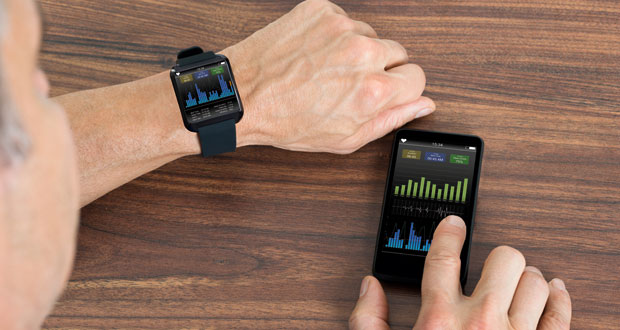Wearable devices made to track and log data are putting the focus on self-monitoring and reducing costs in the sector.
We’re living longer and we want to live better. We’re also living more measured lives as our smart devices and wearables track and monitor many aspects of our movement, sleep and biometrics. As we expose more sensitive health data, we’re becoming more conscious of its value. We’re getting smarter about our health because it now makes economic sense to do so.
In the past, health data was a complex cost managed by a closed set of entrenched players, but the speed of innovation in technology has driven down the price for personalised health monitoring. Self-monitoring via consumer wearables, apps and devices no longer sits primarily in the domain of a small, tech-savvy customer segment. Juniper Research reports that the uptake of fitness and healthcare trackers is estimated to increase by 600 per cent, to $2 billion, between now and 2019, supporting the claim that empowered consumers are interested in keeping track of, learning from, and being rewarded by, their personal health goals.
As it stands, Australia’s healthcare system is incentivised by activity-based, rather than value-based outcomes. It’s also provider-centric rather than consumer-centric. In 2014 alone, private insurers in Australia paid out more than $5.1 billion in healthcare claims. As a result, both the public and private sectors are now looking towards optimising new health data arising from consumer devices and apps to transform industry behaviour and improve outcomes. This approach is allowing the sector to reduce costs and develop services that help individuals monitor their health, detect illness early and reward preventative measures.
An example of this is private health insurer Medibank, which has teamed up with loyalty program flybuys to reward customers’ healthy diet choices and fitness levels. Under the program, each time Medibank members buy fruit and vegetables at Coles supermarkets, they have the opportunity to earn triple the amount of flybuys points, compared with other food items. Members can also link their Fitbit, Garmin, Jawbone or Polar fitness device to collect extra points according to the number of ‘steps’ they take on any given day.
Other companies at the forefront include Orion Health and Precedence Health Care. Orion is advancing software with the idea of ‘precision health’, in which data gleaned from wearables can be used to pinpoint and build personalised recovery plans. At a local level, Precedence is transforming the treatment options for Australians suffering from chronic illness through the online service cdmNet. General practitioners, nurses and other healthcare providers use cdmNet to communicate, plan, follow-up, support, document and manage chronic disease and preventive care. Recently, the service has been extended to allow patients to upload data from wearable technology, which health professionals can access remotely.
Another initiative close to home is the Australian start-up SiSU Wellness. The start-up provides self-serve eHealth stations, which allow users to measure their weight, height, blood pressure, body fat and heart rate. With this information, patients can upload their results to the SiSU Station app to receive personalised health and dietary recommendations and compare results with other individuals in the same age, gender and location bracket.
Beyond specialised healthcare providers, mainstream technology manufacturers such as Samsung and Apple have also been quick to jump on board. Apple’s HealthKit is provided as a free app for every iPhone user. The app is best when synched with a wearable, like a Garmin vivofit or Jawbone’s UP, to provide a precise update on users’ weight, sleeping patterns, heart rate and blood pressure. With users’ permission, it can also provide researchers with rich health data for their studies – such as daily step counts and calorie use. Similarly, Samsung S Health tracks fitness and nutrition levels to allow users to measure and manage their health. The app has partnered with a number of wearables, including activity trackers, smart watches, heart rate bands, ‘smart scales’ and body fat monitors.
As Australians enjoy longer lives, it is no longer the sole responsibility of the government to manage healthcare. As the health industry expands to include start-ups and non-traditional players such as banks and telecommunication providers, organisations need to consider developing the technology, incentives and insights extensive health data can offer, in order to remain competitive.
In doing so, organisations should apply the following considerations as they look to redefine their consumer offerings and move closer to a value-based, consumer-centric system:
- Imagine products and services as wellness agents: to enable new wellness services, organisations are opening their platforms to third parties, including wearables and apps.
- Think beyond the pill: healthcare organisations are now taking to heart the idea that in every product there is a service that’s waiting to happen. This means designing a holistic service offering that provides added value through digital services like telehealth, wellness programs, connected devices and smart pills.
- Work from head to toe: the customer journey has to be rebuilt from the ground up, moving the ‘point of care’ from costly hospitals to the patients’ home and the ‘level of care’ from specialised treatment to new levels of empowered self-service.
As Australia struggles to keep up with rising global health costs, there is an opportunity for new business models and increased revenue to support existing service offerings.
Bronwyn van der Merwe is the Australian lead for global design and innovation consultancy firm Fjord, part of Accenture Interactive.
Do you have an idea for a story?Email [email protected]
 Aged Care Insite Australia's number one aged care news source
Aged Care Insite Australia's number one aged care news source


